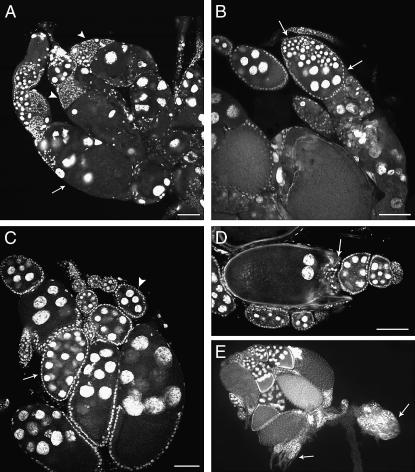Figure 5.—
Soma-dependent FE defects of flam mutants. (A) In 6-day-old flamBG(P) ovaries, follicle cells form aggregates (arrowheads) while large gaps are seen elsewhere in the FE (arrow). (B) Forty-eight-hour-old flamKG(P) ovarioles. Follicle cells fail to invaginate in the germarium, resulting in a compound egg chamber with nurse cells that present various degrees of polyploidization (arrows). (C) A 3-day-old flampy+(P) ovary. Abnormalities are frequently observed during ovarian development. Here a compound egg chamber is present (arrow). Also present is an egg chamber with a deficit in nurse cell number (arrowhead). (D) Stage 11 egg chamber from a 3-day-old flampy+(P) female in which follicle cells have not migrated properly, resulting in nurse cells being pinched off into the ooplasm. Follicle cells accumulate at the anterior of the egg (arrow). (E) A pair of ovaries containing ovarioles with homozygous flamBG(P) germline clones and ovarioles from ovoD1 flam+ germline cells. The ovoD1 flam+ germline cells are arrested at the beginning of oogenesis because of the ovoD1 mutation (arrows). By contrast, in ovarioles in the left ovary, containing flamBG(P) germline clones, germline stem cells divided normally. Bars, 80 μm.

